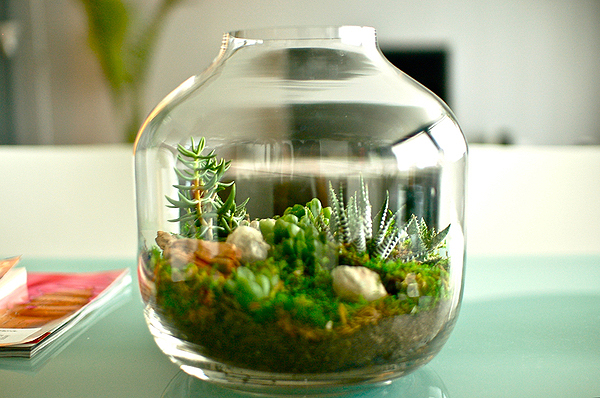
Remember terrariums? They’re tiny gardens planted in clear glass containers. Maybe you made one as a kid at summer camp. Or maybe they can be recalled from their heyday in the 1970s.
These little green worlds were kind of magical. When properly made they needed no watering.
Now terrariums seem to be having another moment in the sun. They are showing up at florists and in garden shops. This time around many of them have an opening at the top.
Those interested might find, or could make, a terrarium in a goldfish bowl or a glass cylinder, an apothecary jar or a shallow dish covered with a glass dome. One could be made in a canning jar (with or without the lid), a brandy snifter or a candy dish.
A terrarium can be the place to create an individually planned miniature landscape. It can be a tiny tropical rainforest, a woodland, a desert (if the container is open) or even a bog.
Even before their brief popularity in the disco era, terrariums had been around for a long, long time. The earliest records there are of glass-en-
closed gardens are from ancient Greece. Around 500 B.C., small plants were grown in bell jars for the festival of Adonis. At the end of the festival the plants were allowed to wither and were then tossed into the Aegean Sea to symbolize the death and regrowth of plant life on earth.
Our modern idea of a terrarium descends from glass boxes, which were called “Wardian cases” in the early 1800s. An English physician, Dr. Nathaniel Ward, was trying to get a hawk moth chrysalis to develop in a glass bottle. He noticed that a fern had begun to grow in a bit of soil in the bottom of the bottle and was intrigued.
Dr. Ward began experimenting. In 1832, he successfully shipped some ferns and grasses in glass containers from England to Australia, thus the Wardian case was born.
Terrariums came to play an important role in international commerce. They enabled banana plants to travel from China to Samoa and Fiji, and rubber trees from Brazil to Ceylon.
The Victorians went crazy for terrariums. They made elaborate ones that looked like little versions of the ornate conservatories they built alongside their homes to hold exotic plants from other parts of the world.
The terrarium environment is essentially self-sustaining in a closed container. Moisture from the soil is absorbed by plant roots and transpired from the leaves as water vapor. That creates humidity in the air that condenses on the inside of the glass and finds its way back to the soil, where the process begins again.
During photosynthesis water from the soil combines with carbon dioxide from the air to form carbohydrates, and oxygen is released as a by-product. The plant leaves take in that oxygen from the air and release CO², or carbon dioxide. Thus, each of these two chemical processes uses the products of the reaction of the other and the terrarium environment waters and nourishes itself as a closed loop. As a result, it’s not necessary to water or feed the plants, or open the terrarium lid to let in air.
Open-top terrariums are also available. Those will need to be watered occasionally.
It’s easy to make a terrarium, and it’s a fun project to do with kids. Start with a clean, clear, glass container. If your container is tall and narrow you’ll need to find some long-handled tools, such as an iced-tea spoon or chopsticks, to help you set the plants into the soil.
To allow excess moisture to drain away from plant roots, spread a couple of inches of pea gravel in the bottom of the container. Follow that with some activated charcoal (sold for use in aquarium filters), about ½ inch deep, to keep the air and water in your little world clean. A layer of unmilled sphagnum moss on top of the charcoal will keep the soil from getting into the charcoal and interfering with filtration.
Finally, spread a few inches of a loose-textured potting mix on top of the moss. In a taller container, make the soil layer deeper.
For those who want to blend their own potting mix, try a blend of two parts potting soil, one part peat moss, one part perlite and one part coarse builder’s sand (not beach!). When making an open-topped desert garden of small succulents and cacti, use more sand.
If the container is wide enough, you can sculpt some hills and valleys in the soil. Make a pleasing arrangement of small planting holes with a teaspoon or your fingers, take the plants out of their pots and set them in the holes, then firm the soil around the base of each plant.
Add some small decorations if you’d like. Small stones can serve as boulders, or maybe you’d like to have a castle made for an aquarium.
Mist the plants and leave the terrarium open for a day or two until the leaves dry. Then put on the lid.
Place the terrarium in a bright place that gets plenty of light but no direct sun, which could heat up and harm the plants.
If the little world should ever seem to be too wet, just open the lid for a couple of days. If it looks too dry, give it a little water.
Don’t fertilize unless the plants look weak and pale. Then apply a liquid plant food diluted to one-quarter the strength recommended on the package.
Plants for a closed terrarium have to love humidity. Look for the smallest pots you can find; two inches is a good size.
Here are some plants to try: ferns, small bromeliads, creeping fig, baby’s tears, oxalis (wood sorrel), fittonia (mosaic plant), peperomia, pilea and miniature begonias and ivies. Carnivorous plants—such as Venus flytrap, pitcher plants and sundews—are also good candidates. Populate an open-topped desert terrarium with little succulents and cacti.